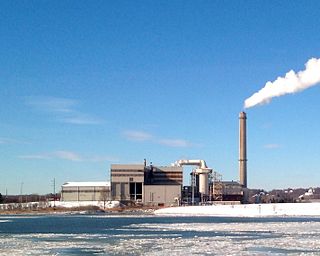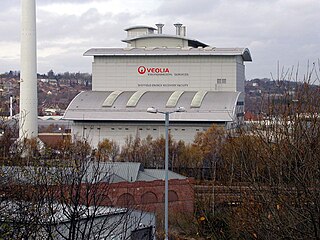
Incineration is a waste treatment process that involves the combustion of substances contained in waste materials. Industrial plants for waste incineration are commonly referred to as waste-to-energy facilities. Incineration and other high-temperature waste treatment systems are described as "thermal treatment". Incineration of waste materials converts the waste into ash, flue gas and heat. The ash is mostly formed by the inorganic constituents of the waste and may take the form of solid lumps or particulates carried by the flue gas. The flue gases must be cleaned of gaseous and particulate pollutants before they are dispersed into the atmosphere. In some cases, the heat that is generated by incineration can be used to generate electric power.

A waste-to-energy plant is a waste management facility that combusts wastes to produce electricity. This type of power plant is sometimes called a trash-to-energy, municipal waste incineration, energy recovery, or resource recovery plant.
Environmental pollution in Japan has accompanied industrialization since the Meiji period. One of the earliest cases was the copper poisoning caused by drainage from the Ashio Copper Mine in Tochigi Prefecture, beginning as early as 1878. Repeated floods occurred in the Watarase River basin, and 1,600 hectares of farmland and towns and villages in Tochigi and Gunma prefectures were damaged by the floodwater, which contained excessive inorganic copper compounds from the Ashio mine. The local breeders led by Shōzō Tanaka, a member of the Lower House from Tochigi appealed to the prefecture and the government to call a halt to the mining operations. Although the mining company paid compensatory money and the government engaged in the embankment works of the Watarase River, no fundamental solution of the problem was achieved.

Waste-to-energy (WtE) or energy-from-waste (EfW) refers to a series of processes designed to convert waste materials into usable forms of energy, typically electricity or heat. As a form of energy recovery, WtE plays a crucial role in both waste management and sustainable energy production by reducing the volume of waste in landfills and providing an alternative energy source.

The Sheffield Energy Recovery Facility, also known as the Energy from Waste Plant, is a modern incinerator which treats Sheffield's household waste. It is notable as it not only provides electricity from the combustion of waste but also supplies heat to a local district heating scheme, making it one of the most advanced, energy efficient incineration plants in the UK. In 2004, the district heating network prevented 15,108 tonnes of CO2 from being released from buildings across the city, compared to energy derived from fossil fuels. The incinerator is a 'static asset' owned by Sheffield City Council and operated by Veolia Environmental Services under a 35 year integrated waste management contract (IWMC)/PFI contract.

South East London Combined Heat and Power, better known as SELCHP, is a major energy from waste incineration plant in Bermondsey, London. It was designed to generate both heat and electricity. The plant can generate up to 35 MegaWatts of power using a steam turbine in electricity only mode. It can incinerate up to 420,000 tonnes per year of municipal solid waste.

Environmental issues in China had risen in tandem with the country's rapid industrialisation, as well as lax environmental oversight especially during the early 2000s. China was ranked 120th out of the 180 countries on the 2020 Environmental Performance Index.

EcoPark is a waste-to-energy plant which burns waste from several London boroughs to provide electricity for the National Grid. It is located on the River Lee Navigation and bordered by the North Circular Road, in Edmonton in the London Borough of Enfield. It is also known as Edmonton EcoPark.
Nuclear power in Taiwan accounts for 2,945 MWe of capacity by means of 1 active plant and 2 reactors. In 2015, before the closure of 3 reactors, they made up around 8.1% of its national primary energy consumption, and 19% of its electricity generation. The technology chosen for the reactors has been General Electric BWR technology for 2 plants and Westinghouse PWR technology for the Maanshan Nuclear Power Plant. Construction of the Lungmen Nuclear Power Plant using the ABWR design has encountered public opposition and a host of delays, and in April 2014 the government decided to suspend construction.
Waste management in Japan today emphasizes not just the efficient and sanitary collection of waste, but also reduction in waste produced and recycling of waste when possible. This has been influenced by its history, particularly periods of significant economic expansion, as well as its geography as a mountainous country with limited space for landfills. Important forms of waste disposal include incineration, recycling and, to a smaller extent, landfills and land reclamation. Although Japan has made progress since the 1990s in reducing waste produced and encouraging recycling, there is still further progress to be made in reducing reliance on incinerators and the garbage sent to landfills. Challenges also exist in the processing of electronic waste and debris left after natural disasters.
The Qidong protest was an environmental protest against a proposed waste water pipeline in the Chinese city of Qidong province. The protest took place on 28 July 2012. The pipeline, which would have dumped industrial waste water into the sea, was to be part of a paper factory owned jointly by Japan's Oji Paper Company. Thousands of citizens took to the streets demanding the cancellation of the project, citing environmental concerns. An estimated 1,000 protesters stormed government offices, overturning vehicles, and forcing the city's mayor to strip off his shirt and instead wear a T-shirt with protest messages. Protests ended after the government promised to permanently suspend the project.

The China PX protest is a series of public demonstrations against the presence of para-xylene (PX) chemical factories in several Chinese cities, including Xiamen, Dalian, Ningbo, Kunming and Maoming among them.
In Hong Kong, domestic waste has always been the largest portion of municipal solid waste. In 2014, domestic waste constitutes 65% of municipal solid waste, and 43% of total solid waste at landfills. Hong Kong has the highest daily domestic waste generation rates per capita compared to other metropolitans in Asia: Metro Tokyo creates 0.77 kg per day per capita, Seoul generates 0.95 kg, Taipei City produces 1.00 kg and Hong Kong tops the rank by 1.36 kg.
Greenaction for Health and Environmental Justice, formed in 1997, is a multiracial grassroots organization based in San Francisco that works with low-income and working class urban, rural, and indigenous communities. It runs campaigns in the United States to build grassroots networks, and advocate for social justice.

The Beitou Refuse Incineration Plant is an incinerator in Zhoumei Borough, Beitou District, Taipei, Taiwan.

The Miaoli County Refuse Incineration Plant is an incinerator in Zhunan Township, Miaoli County, Taiwan. As of December 2019, monthly the incinerator received about 14,260 tons of waste and 14,316 tons of them was incinerated. The plant produced 8.193 GWh of electricity and 83.79% of it was sold to Taipower. It produced 2,454 tones of ashes.

Allerton waste recovery park is a waste recovery and incineration site located on a former quarry at Allerton Mauleverer, near Knaresborough, England. It is operated by AmeyCespa on behalf of North Yorkshire County Council and City of York Council, the site is capable of handling 320,000 tonnes of household waste per year.

The Delaware Valley Resource Recovery Facility is a trash incineration plant located in Chester, Pennsylvania. The waste-to-energy plant, which incinerates waste to generate power, was built and operated by Westinghouse from 1991 to 1997. It is currently operated by Covanta. a Morristown, New Jersey-based publicly traded industrial waste company, and has been criticized for the level of pollution it produces. The plant has the largest capacity of any waste-to-energy plant in the United States.

Gloucestershire Energy from Waste facility, also known as the Javelin Park Incinerator is an incinerator and energy-from-waste power station which produces 14.5MW of energy for the National Grid, by burning up to 190,000 tonnes of residual waste each year. The site is located adjacent to the M5 motorway, near junction 12 and to the south of Gloucester.

The Detroit waste incinerator, also known as the Detroit Resource Recovery Facility and as Detroit Renewable Power was an American waste-to-energy plant that operated in Detroit, Michigan from 1989 until 2019. It was demolished from 2022 to 2023.













